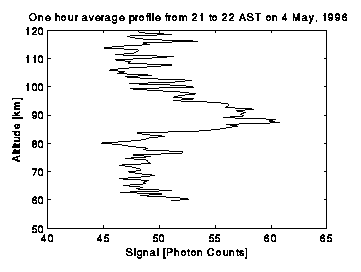
First light for sodium from the Arecibo Observatory resonance lidar. The plot shows the average over one hour of the sodium layer density over Arecibo on 4 May 1996.
[Next] [Previous] [Top] [Contents] [Index]
NAIC/AO Newsletter No. 19
The last Newsletter contained figures showing measurements of He+ and He from the previous series of topside experiments. The latest set of observations will be the last data set of this type for a while. Bob Kerr plans to remove the Boston Fabry-Perot interferometer from Arecibo this spring and ship it to Kitt Peak for the summer to participate in comet studies. Current plans call for reinstalling this instrument in our optical lab in the autumn and continuing these important observations of the topside ionosphere with the other optical instruments and the radar.
The second study that took place during this period was a short World Day experiment, which lasted for only a few hours. Some of the time allocated during this study was also used to measure the plasma properties of the ionosphere, such as temperatures, electron concentration, and line-of-sight ion drift, in support of the NASA Tethered Satellite mission, which was unfortunately less than a complete success. Nevertheless, some useful observations were obtained during the brief time that the tether was deployed.
As work on the Gregorian upgrade continues, the use of the radar systems becomes increasingly restricted. However, optical observations of the atmosphere continue at full speed. The alexandrite-laser-based tunable lidar has become fully operational early this year. In March, Paul Castleberg (Cornell) and Jonathan Friedman (NAIC) used the new lidar to excite potassium resonance emission at 770 nm from atoms believed to be produced by meteor ablation in the 80 to 110-km altitude range. They were also able to determine the temperature of the neutral atmosphere between about 25 and 65 km altitude from the Rayleigh backscatter of the 770-nm laser light.
We used this deep-red wavelength for these initial measurements because it was within the fundamental pass-band of the alexandrite laser, thus not requiring additional frequency-conversion techniques. However, it is possible to tune this laser to other wavelengths, that is, to excite other resonance fluorescence lines, that are the characteristic fingerprints of other metals residing in the upper atmosphere. One of these metals is sodium. After two levels of frequency conversion our laser transmits only a few millijoules of energy at 589 nm, the sodium resonance wavelength. However, sodium is abundant and has a large scattering cross section.

These preliminary observations demonstrate the initial operation of this new resonance fluorescence lidar that was recently installed at the Arecibo Observatory. We will use this new instrument to study the details of the upper atmosphere using metallic species as tracers.
On the 6th and 7th of May 1996, Robert Robinson of the NSF and this committee visited Arecibo to review our facility and its atmospheric sciences program. Paul Goldsmith reviewed the structure and budget of NAIC and the Arecibo Observatory while Daniel Altschuler discussed our educational program and the new visitor center currently under construction. Craig Tepley discussed some of the details of our atmospheric sciences program, its instrumentation, and future plans. This was followed by short scientific talks on the current research interests of each atmospheric sciences staff member.
During the course of the two days, the committee members were treated to several site tours including visits to the HF Facility, the transmitters and receivers at the main site, the Optical Laboratory with its "Grease Pit Laboratory" outpost that currently houses the new resonance lidar, the Gregorian dome enclosure, the construction site of the Visitor and Education Facility, and the Electronics Laboratory. After additional discussions with the scientific and managerial staff, the committee left late in the afternoon on the second day and made their way to Jicamarca. We trust that they were suitably impressed by what they saw and heard while at Arecibo.
[Next] [Previous] [Top] [Contents] [Index]
Generated with Harlequin WebMaker